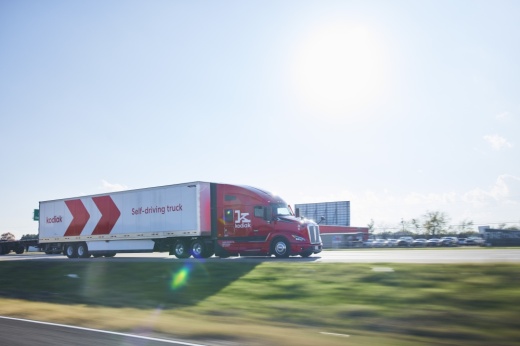Two minute impact
Leading the charge in the Austin area is autonomous truck company Kodiak Robotics, which is already hauling goods daily in Texas.
Currently, Kodiak trucks have a “safety driver” monitoring the truck as it carries freight for hundreds of miles. By the end of the year, Kodiak will send trucks out unmanned.
Autonomous vehicles could resolve supply chain issues and make life for truck drivers easier, Dan Goff, head of policy at Kodiak, said.
However, John Esparza, president and CEO of the Texas Trucking Association, said officials and trucking companies aren’t looking to eliminate human drivers.
“We are improving the safety of our highways and the efficiency by which we move freight,” he said.
Part of the effort by state officials to enhance safety includes upgrading a 21-mile stretch of SH 130—running through Pflugerville and Hutto—with new technology to help guide automated trucks.
The breakdown
In the U.S., 25 states have enacted legislation to deploy autonomous vehicles, while another 12 allow for testing, according to the Insurance Institute for Highway Safety.
In Texas, over a dozen companies have tested or begun operating some type of self-driving vehicle.
Most recently, self-driving car company Zoox announced in July it will begin testing in Austin this summer. Mars Auto, which develops autonomous long-haul trucks, also announced it will move its operations to Round Rock this year.
Autonomous vehicle companies are required to self-report any crash incidents to the National Highway Traffic Safety Administration.
Waymo and Cruise, which build self-driving passenger cars, take the lead in collisions among 39 companies, with 335 and 152 crashes respectively, according to data collected from July 2021 to June 17 by the NHTSA. Third in line is General Motors, which owns Cruise, with 145 crashes.
Goff said autonomous trucks differ from cars as they have more predictable driving patterns and fewer obstacles, such as pedestrians, cyclists and stop lights. Cruise and Waymo also have larger fleets than autonomous truck companies do.
“The Kodiak system doesn’t get tired; it doesn’t get distracted; it doesn’t check its phone; it doesn’t have a bad day and take it out on the road,” he said.The why
Texas roads have been ideal for autonomous trucking companies, Goff said, as the state has some of the most lucrative freight routes in the nation and legislators have welcomed the new innovation.
The supportive culture sprouted from Senate Bill 2205, a law passed by the Texas Legislature in 2017 that prohibits cities from regulating autonomous vehicles.
“Trucks lead the country in the technologies and the policies that they adopt and utilize to keep drivers safe,” Esparza said. “And why wouldn’t we? We’re talking about an 80,000-pound vehicle that the driver will drive an average of 100,000 miles a year.”
Esparza said that while human drivers can put in many hours behind the wheel, they are still required to rest and limit their weekly driving. Driverless vehicles aren’t limited to these hour requirements.
“How much more efficient can we be moving freight, even if it’s just a fraction of freight today?”
Truck driving limits
Texas’ truck driving laws differ from federal rules, and include:
- 12 hours of driving within a 15-hour on-duty window
- 8 consecutive hours of off-duty rest before beginning shift
- Maximum of 70 hours of driving within 7-day span
- Drivers must take 34 consecutive hours of rest to reset their cycle
- 11 maximum driving hours within a 14-hour on-duty window
- 10 consecutive hours of rest required after 14-hour window
- Drivers can’t work more than 60 hours in a 7-day period
- No more than 70 hours in an 8-day period
- Drivers must rest for 34 hours following the 70-hour driving limit
Abraham Vela, owner of LSA Logistics, a shipping company in Pflugerville, said an influx of under-qualified, or inexperienced, drivers joining the industry in 2020 created a “domino effect.”
He said this caused companies to start lowering their rates, in some instances offering to haul loads for 50% less than what was being asked.
“Now, if you want to take a load, you take it for way less than what it used to be,” he said. “Then if you don’t have anything [to bring] back, you’re kind of in the negative going back home or going to a different location. It’s just too cheap.”
An increase in traffic accidents and damaged cargo, he said, have also led to higher insurance rates. Meanwhile, operating costs for trucking companies have increased.
The average marginal cost to motor carriers per hour, according to a report by the American Transportation Research Institute, reached a record high in 2023 at $2.270 per mile. When looking at the average trucking cost to companies per hour, it rose from $66.94 in 2019 to $91.27 in 2023.
Additionally, accounting firm PwC estimates—based on a survey of 128 large and mid-size U.S. manufacturers and transportation companies—that autonomous, long-haul trucking could save manufacturers nearly 30% in total transportation costs through 2040.What’s next
The Texas Department of Transportation and road technology company Cavnue will establish a “smart corridor,” featuring sensors and cameras, on SH 130 from Georgetown through Del Valle in 2025.
“SH 130 is one of many advanced toll roads in Texas with several technologies already like fiber, cellular, cameras and tolling facilities,” said Darran Anderson, TxDOT’s director of strategy and innovation.
Amy Madison, former director of the Pflugerville Community Development Corporation, said the corridor can help streamline the transportation of goods and services, and “potentially” save lives.






